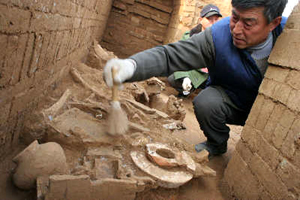12 archeological sites unearthed in Beijing
|
Archeologists have discovered 12 cultural heritage sites and ancient tombs during the construction of the Beijing section of the south-to-north water diversion project. Excavation has started to unearth the relic sites, which are located near Nanzheng village in Fangshan district, southwest Beijing.
At Nanzheng heritage site, one of the biggest covering 6,100 square meters, archeologists have unearthed, after two weeks of excavation, 10 tombs and three pottery kilns that date back to the Western and Eastern Han Dynasties (206 BC - AD 220), said Zhang Zhiqiang, who is in charge of archeological work along the 80-kilometer-long Beijing section of the water diversion project. The site contains large quantities of bronze and ceramic wares and ancient coins, he said. At Yanshangmu site north of Nanzheng village, Zhang and his colleagues have found 59 tombs from the Han, Tang (618-907), Ming (1368-1644) and Qing (1644-1911) dynasties. While most of the heritage sites date back to the Han dynasties, experts say some ruins of ancient structures and ashpits in Dingjiawa village could date back to the Xia (21-16 cent. BC) and Shang (16-11 cent. BC) dynasties, the earliest stage of recorded Chinese history. Dingjiawa site also contains nine tombs of the Liao (916 - 1125) and Jin (1115 - 1234) dynasties, Zhang said. The south-to-north water diversion project, which runs across eight provinces and regions, provides an "unprecedented opportunity" across vast areas for Chinese archaeologists, he added.. "These findings will help us study the life and production of ancient villages and townships more than 2,000 years ago in Beijing," said Kong Fanzhi, vice-director of Beijing Municipal Bureau of Cultural Heritage. He added it would help to fill in gaps within Beijing's history, which can be traced back to more than 3,000 years ago. The water diversion project consists of three canals, each running more than 1,200 kilometers across the eastern, central and western parts of the country. The eastern and central routes of the scheme will involve the protection of more than 700 major cultural heritage sites, with a planned excavation area surpassing 1.6 million square meters. Last November, the Chinese Government decided to allocate 50 million yuan (6.2 million U.S. dollars) for the preservation of 45major cultural heritage sites along the two routes. Archaeologists in the capital completed an exploration area of 2.72 million square meters from July to December last year. All the archaeological excavation work will be finished before June 30, when an underground canal will be dug on the sites in Fangshan and Fengtai districts for the use of water diversion.
|


